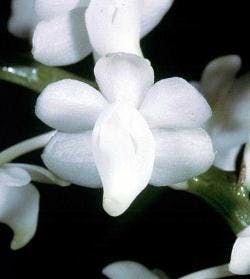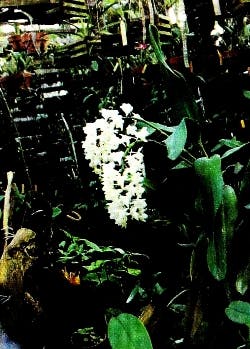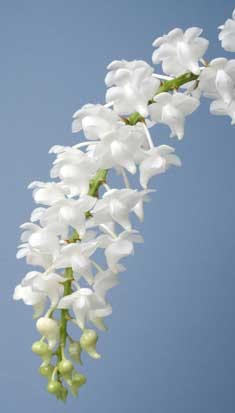Aerides quinquevulnera var. farmeri
"Orchid of the Sacred Sleep"
DR. E. NOEL ALOJIPAN, JR.

Aerides quinquevulnera f. farmeri 'Matsuki', AM/AOS grown by Ken Fujimoto. Photograph copyright Paul Tuskes
AERIDES QUINQUEVULNERA FORMA FARMERI Stein is a monopodial, epiphytic orchid with sturdy, upright stems which are round and thick, a characteristic that is common to the genus. The leaves are strap-shaped, keeled, particularly nearing the base, and are two-lobed at the apex. They are leathery, twenty-six to thirty-two centimeters long, about two and a-half to four centimeters wide, with uneven undulations along the axis so that they do not appear flat or straight. They are closely arranged on the stem alternately on opposite sides (distichous), with the leaf bases enclosing the stem. Roots are very robust, about the size of a lead pencil, abundant and branching, aerial, but most tend to cling to the media for support. Growth is continuous throughout the year, but a definite flower-ing season is observed from August to September only.
One to three inflorescences appear at the axils of the mature leaves. These start off as upright spikes then abruptly arch downwards commencing at or near the first flower buds, very similar to the spiking characteristics of Aerides jarckiana. The spikes are thick and, during the development of the buds, secrete a viscid fluid which is rather sweet, thereby attracting ants. The flower buds are numerous, racemose in appearance and, as floral development to maturity approaches, arrange themselves in such a way that the flowers are displayed in the proper perspective to the viewer; i.e., flowers face all sides. The flowers are fleshy, waxy, immaculately white and mint-scented, particularly strong in the early morning, and are arranged in a racemose manner from the base to the tip. Flowers are about two and a-half centimeters wide, with well-rounded dorsal and lateral sepals, as well as petals which are similar to the dorsal sepal.
The lip is typical of the Aerides group, three-lobed, spurred and attached to the foot of the column which is also pure white. The two lateral lobes are perpendicular to the sepals while the apical lobe curves upward towards the column. In fact, in the fresh state, the two lateral lobes clasp the column from the sides, while the apical lobe covers the front or face of the column, particularly the anther cap. The margin of the apical lobe is waxy. The column of Aerides quinquevulnera f. farmeri is short, rests on a peduncle at the base, and ends in a beak at its apex. It is broader at its base and narrows down to the stigmatic surface. The yellow pollinia are attached to a Y-shaped caudicle with a transparent, shield-shaped foot which contains a sticky substance (FIGURE 1).

CULTURAL PREFERENCES
While the plant resembles the typical Aerides quinquevulnera species which is relatively easy to culture "in captivity", this particular variety had top-rotted twice when it was allowed to grow in a pot under a caimito tree (Chrysophyllum caimito), exposed to the elements during the rainy season. Until its identification and the realization of its horticultural rarity and botanical value, my plant was not given much attention. Since then, however, Aerides quinquevulnera var. farmeri has been placed inside the greenhouse, protected from rain but kept moist, with only about 30% to 40% sunlight. The plant has been very vigorous, producing a number of keikis from its main stem. I have also noticed that it attached itself very well to a stump of kakawate (Gliricidia septum) to which the pot with charcoal medium had been attached (FIGURE 2). When well-grown, Aerides quinquevulnera f. farmeri can produce a spectacular inflorescence (FIGURE 3).
BOTANICAL SIGNIFICANCE
While the Aerides group of orchids is widely distributed in the Far East from Japan and China south through Indo-China, the Himalayas, Burma, Indonesia and the Philippines to New Guinea, with over sixty species attributed to the genus, Aerides quinquevulnera var. farmeri is believed to be quite rare. In fact, the last record of its existence was written by Mr. Aleko E. Lilius, an American journalist-explorer who found the orchid in Calayan Island, the Philippines, in 1932. This was, according to Dr. Eduardo Quisumbing, then Head of the Department of Botany of the Bureau of Science, ". . . the first time it has been shown in Manila, and apparently, the second in the world." The first time was in 1862 when Mr. W. F. G. Farmer showed it in Nonsuch Park, Cheam, England. No mention as to its origin was made. Dr. Quisumbing qualified the plant as one of the ", . . world's rarest finds!" When the plant was shown during the 1978 Mid-year Orchid Show of the Philippine Orchid Society, it was awarded "Best in Show". By all indications, this was only its third appearance in the whole world.
LEGENDARY BACKGROUND

Figure 2 Aerides quinquevulnera f. farmeri in the author's greenhouse.
The genera Aerides and Rhynchostylis have often been referred to collectively as the "Fox-tail" orchids because of their inflorescence characteristics, resembling the tail of a fox notably because of the droop and the conical shape of the raceme. The generic name Aerides, however, is literally translated as "Children-of-the-Air." Mr. Aleko Lilius, the American journalist-explorer mentioned earlier, apparently went to Calayan Island in the Babuyan Group north of Luzon, the Philippines, in search of a legendary orchid which the natives called "Saguy Yepyep" or "Flower of the Sacred Sleep." The full story is unclear except from what can be inferred from the remarks of Mr. Lilius when he said, ". . . all for the sake of an adventuring journalist's foolishly uncommercial respect for pagan traditions about a chieftain and his maiden, whose love gave birth to a rare jungle flower, one of the rarest in the world." The legend, however, produced native worshippers who, in spite of their conversion to Christianity, adhered to ancient traditions and special rites such as a Flower Fiesta, and a very special, sacred, and secret ritual for the Orchid of the Sacred Sleep. This tradition was maintained complete with a high-priestess-guardian for the venerated plant, one who admitted that the words and phrases she used during the ceremony she herself could not understand.

Figure 3 Aerides quinquevulnera f. farmeri 'Helen's Snow Dove', AM/AOS awarded under the name Aerides quinquevulnera var. alba. Grown by Mac's Orchids. Photograph copyright Greg Allikas, Orchidworks.com
It would be interesting to find out if there are present inhabitants of the island of Calayan who still remember the legend of the "Orchid of the Sacred Sleep," much less believe in it. It might be of great ethnic significance and cultural value to be able to put in print the whole story and its effects on the lives of the natives of Calayan Island. Perhaps, some day, someone shall be able to expose the mystery behind the "Orchid of the Sacred Sleep." At the moment, I can only share in the exultation of Mr. Aleko Lilius when he discovered the plant itself, the fabled "Orchid of the Sacred Sleep," and brought a colony of it to Manila in September, 1932, which was identified by Dr. Eduardo Quisumbing as the rare and lovely Aerides quinquevulnerum f. farmeri.
REFERENCES
- Ames, O. and E. Quisumbing. 1933. New or Noteworthy Philippine Orchids IV. Phil. Jour. Sci. 56: 458-459.
- Alojipan, E. N., Jr. 1977. Philippine Foxtails. The P. 0. S. Jour. 1 (1): 13-14.
- - 1978. "Orchid of the Sacred Sleep": A Rediscovery. Souv. Prog. P. 0. S. 1978 Mid-year Show. 32-33.
- Lilius, A. E. 1933. The Priceless Orchid of the Sacred Sleep. Phil. Tour. Topics 1(5): 39-40, as reprinted in Phil. Orchid Review 2 (3): 16-22 (1949).
- Price, G. R. 1972. Philippine Aerides. Pollinia 1 (2): 8-14.
- Shuttleworth, F. S., Zim, H.S. and G. W. Dillon. 1970. Orchids: A Golden Nature Guide. Golden Press, New York.
- Steiner, M. L. 1960. Philippine Ornamental Plants. Carmelo and Bauermann, Inc., Manila.
- - 1949. A Study of the Genus Aerides in the Philippines. Phil. Orchid Review 2 (3): 3-8.
- Wood, J. and G. Kennedy. 1977. Some Members of the Genus Aerides. Orchid Digest 41: 205-208.









